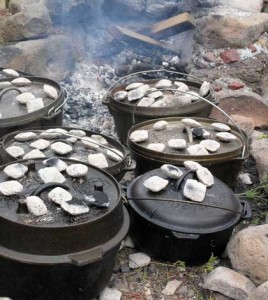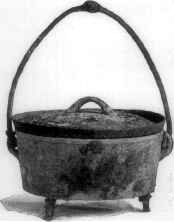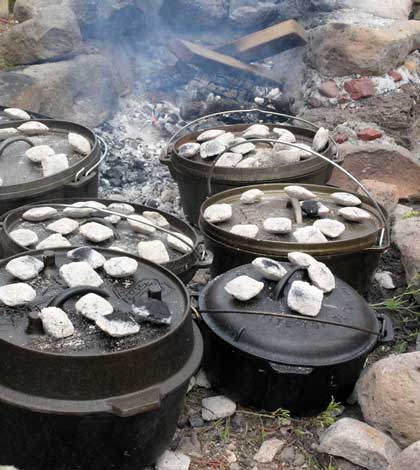
There are few things as tasty as a “one pot meal” of meat, veggies, and herbs and spices all cooked for a few hours in a Dutch oven.
An incredibly simple and straightforward cooking tool that has been used for hundreds and hundreds of years, the Dutch oven is enjoying quite a bit of a comeback in recent times. Most of this is thanks to the popularity of camping, hiking, and a culture interested in breathing new life into traditional methods of cooking.
If you would like to get started cooking with a Dutch oven, but have no idea where to begin, you will find all of the answers you need in this quick breakdown. Just remember that Dutch oven cooking is all about simplicity and is one pot cooking at its best. Check out our ULTIMATE GUIDE TO OUTDOOR COOKING for some great tips.
It’s nearly impossible to screw up!
Choosing your Dutch oven
Not all Dutch ovens are created equal.
Sure, the overall design of these cooking instruments are pretty standardized across the board – but each and every brand, manufacturer, and even “era” of Dutch oven products have subtle variations that need to be addressed before moving forward.
Most new Dutch ovens are manufactured out of cast-iron, and very frequently are lined with enamel on the inside as well as the outside. This provides a nonstick surface almost right off the bat that is both beautiful and durable, though it will require a bit of attention when it comes to cleaning, care, and maintenance.
Aluminum Dutch oven options also exist, as well as heirloom style options that were crafted out of earthen materials fired in a kill. Aluminum ovens are usually half the weight of cast-iron options, but do not have the same kind of durability or heat retention capabilities that cast-iron would.
Of course, aluminum Dutch ovens will not need to be cured before use – and frequently are much easier to clean and maintain. Weight considerations are going to be important when choosing your new Dutch oven, but think about how you intend to use it (and how far you intend to transport it) before allowing it to be the deciding factor.
Other important considerations that you’ll need to keep in mind before purchasing your new oven is whether or not it has legs or has a flat bottom (legs are always preferred), that it comes with a tight fitting lid free of gaps, that the thickness of the oven is consistent all the way around, and that the handle is sturdy enough and durable enough to support the weight of the oven when completely filled to the brim with cooking ingredients.
So long as these factors are checked off, you should have no trouble whatsoever getting your hands on the best Dutch oven out there.
The importance of curing
Before you start to fire up your Dutch oven to cook with the first time around, you’re going to need to do a bit of prep work and cure it – but only if it is made out of raw cast-iron. This curing process basically seals cooking oils and fat into the gaps between the cast iron particles, creating a nonstick surface even more slippery than the best silicon or Teflon!
Enameled Dutch ovens and aluminum Dutch ovens will not require any curing whatsoever, as they already have nonstick properties that would not be improved (and might even be hampered or damaged) be going through the curing process.
If you’re Dutch oven is brand-new, the curing process is going to be pretty easy and straightforward.
You’ll want to preheat your regular kitchen oven to right around 200°F, only afterwards popping your Dutch oven into it. Once you’ve reached that temperature (and it should only take three or four minutes at most), you’ll want to remove the Dutch oven and begin coating the entire cooking surface with your choice of fat, oil, or lard.
You only want to use enough to completely coat the entire surface without any pooling at the bottom, but also need to make sure that you hit the entire surface without leaving any gaps at all. Once you have made sure that everything is good to go, pop it back into your oven and crank the heat up to 350°F – leaving it in there for about an hour.
There’s going to be more than a little bit of smoke, but that’s to be expected. After the hour at 350°F is up, you’ll want to turn the oven off – but do not remove the Dutch oven from inside. Allow it to cool back down with the temperatures of the oven, letting it sit for at least an hour and a half or so after you have killed the heat.
Usually you will only need to go through curing one time and one time only, but it’s a good idea to inspect your oven to make sure that it’s reached the desired level of nonstick that you were hoping for. If it hasn’t, don’t be afraid of repeating the process as much as you need to until it’s exactly the way you like it.
It’s also a good idea to rub in a bit of cooking fat after every single use of your Dutch oven – and never wash it with soap or any other detergent!
If your Dutch oven is old, rusty, or a bit of an antique, you’ll need to use varying levels of sandpaper to scrub the surface down to raw cast-iron, and then follow the steps outlined above to create the same kind of nonstick surface that you’re after.
Many dutch ovens come preseasoned, thus all this work only needs done if the dutch oven needs to be reseasoned.
Must have Dutch oven cooking accessories
Cooking in a Dutch oven is a breeze.
After all, usually all you have to do is fill the Dutch oven with ingredients and then lay it on top of a direct heat source, sitting back and relaxing while it does the bulk of the heavy lifting. Even still, you are going to need some unique cooking accessories to get the most out of this tool.
Oven gloves that can protect your hands from high heat are essential, and you may even want to consider leather blacksmiths gloves if you plan to cook with your Dutch oven outdoors on an open fire. The heat from a campfire isn’t going to be quite as easily regulated as in an oven or on top of a stove, which is why you want to make sure that your hands are always protected when it comes time to pull the Dutch oven off of the heat.
Secondly, you’ll want to make sure that you have a high quality “lid lifter” on hand. This is usually an aluminum or cast-iron hook type instrument that allows you to get right inside of the handle on the Dutch oven lid, popping it off without ever risking contact. It should be strong, durable, and long enough to maneuver safely so that you never have to worry about dropping a hot Dutch oven lid on your feet!
A garden trowel, entrenching tool, or other small shovel is also going to be useful when cooking with a Dutch oven – but only if you anticipate cooking on this instrument outdoors. This will allow you to easily maneuver hot coals from one side of the Dutch oven to another, redistributing heat more evenly, or even putting some coals on the top.
Tips and tricks for cooking with your new Dutch oven
As mentioned above, cooking on a Dutch oven is almost foolishly simple.
All you really have to do is fill your Dutch oven with your raw ingredients (usually meat, vegetables, and a bit of broth, water, or stock to braise, boil, or simmer everything in), and then place the Dutch oven directly on top of a heat source. Heaping coals on top of the lid will also help to redistribute heat for even cooking and speedier cook times.
To make sure that you are evenly heating your Dutch oven, you’ll want to stick to the “2/2/2 Rule”.
This basically dictates that you have two coals per inch of oven diameter underneath the stove, that you have two extra coals per inch on top of the oven lid, and that you try to keep two eyeballs on the oven while cooking with it.
If you stick to the 2/2/2 Rule, you should have no headaches or hassles when cooking with a Dutch oven – even if you never have used one before!

An additional step that can be taken to even out the cooking temperature is to turn the oven regularly. Just turn the entire dutch 90 degrees every 15 minutes. This way if there is a hot spot near the dutch oven it doesn’t burn the one spot of the contents. If there are coals on the lid, turn it in relation to the bottom too.
For those that plan to cook meat or a meat-based dish in a Dutch oven, it’s a great idea to first brown the meat inside of the Dutch oven before adding the rest of the ingredients.
This basically involves heating up your Dutch oven for at least 15 minutes, only adding the chunks of meat to the pot after it has reached the perfect temperature (just when the fat or oil begins to smoke gently).
You’ll then want to leave the meat alone until it develops a brown, seared, almost heavenly texture on one side, flipping it (only once) to allow the process to duplicate itself on the other side. After about 20 or 30 minutes or so (give or take), the meat will be sufficiently browned and then you can safely add the rest of your ingredients and your water or stock to whip up one of the most incredible meals you’ve ever tasted!
Definitely a bit of a throwback cooking method and cooking tool, don’t be surprised if your Dutch oven has you eating like a frontiersman much more often than you had ever expected – and quickly becomes your favorite tool for cooking braises, stews, or other “comfort foods” (inside the house or out)!



